#Earl Blumenauer
Explore tagged Tumblr posts
Text
TriMet Celebrates Hydrogen Buses Coming to 82nd Ave
On Thursday, October 17th, TriMet leaders and members of Oregon’s congressional delegation gathered in a warehouse on NE Columbia Boulevard to address attendees. This celebratory event marked the $69 million public investment that will transform a former industrial site into a hub for hydrogen fuel-cell electric buses that will serve 82nd Avenue. Federal funds will help TriMet purchase the…
0 notes
Text
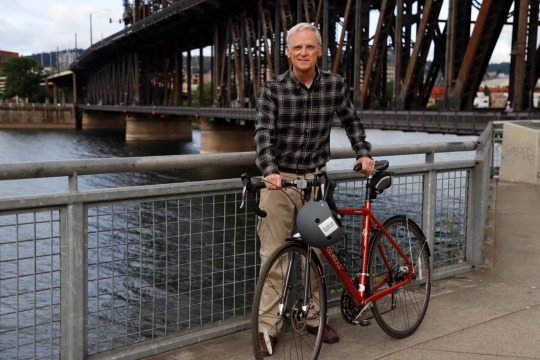
Congressman Blumenauer Is Bicycling’s Biggest Advocate
0 notes
Text
NORML: U.S. Congress: Legislation Introduced To Get The Feds Out of The Marijuana Enforcement Business
Source:NORML Representative Jared Polis has been against the War on Drugs and in favor of marijuana legalization as long as I’ve known of him and I believe he was elected to the House in 2007. And has worked with Ethan Nadelman and other anti-drug war groups in Colorado the state he represents and other places. So Representative Polis is not a Johnny-come-lately to marijuana legalization. Someone…
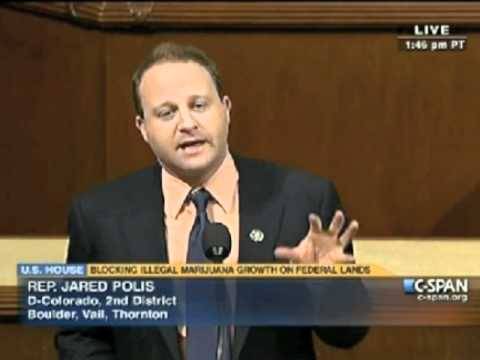
View On WordPress
#114th Congress#2015#America#American Drug War#Cannabis#Center Right#Classical Liberalism#Classical Liberals#Colorado#Controlled Substance Act#Democratic Party#Drug War#Earl Blumenauer#House Democrats#Jared Polis#Liberalism#Liberals#Marijuana#Marijuana Legalization#Pot#U.S. Congress#U.S. Government#U.S. House of Representatives#United States#Washington#Washington DC
0 notes
Text
god but watching all the ascension stuff w/ramza last night has me so insane about xarrastarion. because like the thing is he never really Stops wanting to manipulate them up until the ritual happens (there is some nuance to what’s happening After that if i get into now i’ll get nothing done at work today at all lol) but just instead of “how can i keep myself safe” it’s “how can i keep them mine” and it’s not about possessiveness (deeply not a thing for the two of them) it’s about well. that one fucking line after you ascend him. “he will always see you as degrading yourself if you continue to be with him.” and it’s not about being insecure or whatever like idk it would be very easy to woobify him here and to be like “poor baby is insecure and sad etc etc etc” and yeah there’s an element here of like. feeling unworthy or whatever. but he’s not really wallowing in that? it’s not the tear filled “why would you ever love someone like me :((((((“ conversations i think people want to see with characters like this it’s very much like. i’m going to do everything i can to Make you love me. i know you said you care for me but the clock is ticking and eventually my burdens will be too much to bear and i have to make the value proposition of my being in your life sound appealing despite all that. he feels that way regardless, but once you get to the ritual the difference between ascended and spawn endings is that for ascended it’s “maybe you like degrading yourself” and spawn recognizes that they don’t see it as degrading at all.
and i think with xarrai specifically like. he believes they care for him. he believes they intend to help him kill cazador come hell or high water. but he also believes them to be someone who is calculating and always aware of the cost and benefit of keeping people around (whether he’s 100% right about that is a different story tho) and so he feels like. idk. the stakes feel high no matter how honestly they try to show him they care for him and need and want nothing else from him. i feel like that line after the spawn ambush that’s like “i’m doing this for you too, you know. to make sure we’re both safe.” is exactly the heart of it - it’s a very valid interpretation to say that’s more manipulation and is entirely a lie but i think there’s something compelling in seeing it as true. manipulative to an extent, but true. xarrai could tell him honestly and plainly that they absolutely want nothing more than his companionship and he would Still be trying to find a way to keep them his because i think the idea of losing what they have, of losing whatever “something real” means is like. unthinkable. and drives him to consider ascension the only option because it would allow him to keep hold of the things he wants and loves; power, sunlight, and them.
#had a whole conversation with a united states congressman in the middle of writing this post btw#shoutouts to earl blumenauer i guess#ANYWAY this is rambly and all over the place but i’m like. so so so compelled by like#idk. neither of them know what something real is.#but as long as power is on the table it is an Option and it’s not until xarrai lays out plainly what they know he’s thinking#that astarion recognizes that making them his spawn would. not be something real.#but there are 100% other factors and also by the time they’re talking about it it is Very late in the game for him to change his mind#IDK i think the manipulation that continues to happen even After he decides to stop manipulating them is soooo interesting#because like. he doesn’t know how to do anything without manipulation#and like. well. he can’t be certain they’re not still manipulating him.#he’s in love with them and he trusts them but he also knows. because they are mirrors of one another. that they’re still a manipulator#how can either of them ever be anything else?#i like them. is thing.#and do not want to be working rn#i need to put my phone away before mr congressman comes back goodbye#漫言#oc. xarrai#r. hold me like a knife
2 notes
·
View notes
Text
Earl Blumenauer’s unfinished weed business
The Oregon lawmaker has championed cannabis policy changes on Capitol Hill for nearly three decades. Half a century ago, a Republican hog farmer delivered the most convincing argument for cannabis legalization Earl Blumenauer has ever heard. Stafford Hansell, a 60-year-old state senator, was a lead sponsor of Oregon’s groundbreaking 1973 marijuana decriminalization bill. Hansell held up a…
0 notes
Text
@elonmusk
These awful people all need to be voted out, either in the primaries or the general election. They sully the Capitol Building with their presence.
THESE ARE THE 158 DEMOCRATS WHO VOTED AGAINST DEPORTING SEX OFFENDERS Alabama: -Terri Sewell California: -Pete Aguilar -Ami Bera -Julia Brownley -Salud Carbajal -Tony Cárdenas -Judy Chu -Jim Costa -Mark DeSaulnier -John Garamendi -Robert Garcia -Sylvia Garcia -Jimmy Gomez -Jared Huffman -Ro Khanna -Sydney Kamlager-Dove -Barbara Lee -Ted Lieu -Zoe Lofgren -Doris Matsui -Kevin Mullin -Grace Napolitano -Nancy Pelosi -Katie Porter -Linda Sánchez -Adam Schiff -Brad Sherman -Norma Torres -Mike Thompson -Maxine Waters Colorado: -Jason Crow -Diana DeGette -Brittany Pettersen -Joe Neguse Connecticut: -Rosa DeLauro -John Larson -James Himes Delaware: -Lisa Blunt Rochester Florida: -Kathy Castor -Sheila Cherfilus-McCormick -Lois Frankel -Maxwell Frost -Darren Soto -Frederica Wilson -Debbie Wasserman Schultz Georgia: -Sanford D. Bishop Jr. -Lucy McBath -Henry “Hank” Johnson -Nikema Williams -David Scott Hawaii: -Ed Case -Jill Tokuda Illinois: -Sean Casten -Danny Davis -Jesús “Chuy” Garcia -Jonathan Jackson -Raja Krishnamoorthi -Robin Kelly -Delia Ramirez -Janice Schakowsky -Mike Quigley -Bill Foster -Brad Schneider -Lauren Underwood Indiana: -André Carson Kentucky: -Morgan McGarvey Louisiana: -Troy Carter Maine: -Chellie Pingree Maryland: -Steny Hoyer -Glenn Ivey -Kweisi Mfume -Jamie Raskin C.A. Dutch Ruppersberger -John Sarbanes -David Trone Massachusetts: -Jake Auchincloss -Katherine Clark -Bill Keating -Seth Moulton -Ayanna Pressley -Richard Neal -Lori Trahan -James McGovern Michigan: -Dan Kildee -Debbie Dingell -Rashida Tlaib -Shri Thanedar -Haley Stevens Minnesota: -Betty McCollum -Ilhan Omar -Dean Phillips Mississippi: -Bennie Thompson Missouri: -Cori Bush -Emanuel Cleaver New Hampshire: -Ann Kuster New Jersey: -Andy Kim -Rob Menendez -Donald Norcross -Bonnie Watson Coleman -Frank Pallone New Mexico: -Melanie Stansbury -Teresa Leger Fernandez New York: -Jamaal Bowman -Adriano Espaillat -Hakeem Jeffries -Yvette Clarke -Gregory Meeks -Alexandria Ocasio-Cortez -Jerrold Nadler -Nydia Velázquez -Paul Tonko -Dan Goldman -Ritchie Torres -Grace Meng -Joseph Morelle North Carolina: -Alma Adams -Valerie Foushee -Deborah Ross Ohio: -Shontel Brown -Joyce Beatty -Greg Landsman Oregon: -Earl Blumenauer -Suzanne Bonamici -Valerie Hoyle Pennsylvania: -Madeleine Dean -Mary Scanlon -Summer Lee Rhode Island: -Gabe Amo South Carolina: -James Clyburn Tennessee: -Steve Cohen Texas: -Greg Casar -Veronica Escobar -Joaquin Castro -Sylvia Garcia -Lloyd Doggett -Lizzie Fletcher -Al Green -Jasmine Crockett -Marc Veasey Vermont: -Becca Balint Virginia: -Donald Beyer -Gerald Connolly -Jennifer McClellan -Bobby Scott Washington: -Suzan DelBene -Derek Kilmer -Rick Larsen -Marilyn Strickland -Pramila Jayapal Wisconsin: -Gwen Moore -Mark Pocan Source: Newsweek
54 notes
·
View notes
Text
At the heart of Blumenauer’s bill is farm subsidy reform. In the most recent iteration of the farm bill, approximately $63bn was dedicated to subsidies. These mostly benefited the largest farms and agribusinesses, with 70% of subsidy payments going to just 10% of farms, most of which produce commodity crops like soy, corn and wheat, which are often used to make animal feed, processed foods and even fuel for cars. This means that taxpayers are subsidizing processed food, but not the fruits and vegetables you buy in the grocery store – and that commodity farms have little incentive to switch to more sustainable modes of production or more nutritious foods that people will actually eat. “Most of us don’t even know that the public dollars initially designed to protect farmers and keep supply managed to feed a hungry nation in the Great Depression are now reinforcing wealthy agribusiness corporations to grow commodities that are not even meant for human consumption,” said Joshua Sewell, a policy analyst at the nonpartisan watchdog group Taxpayers for Common Sense. Farmers that grow what are called “specialty crops”, which include fruits and vegetables, usually don’t qualify for subsidies. Most of the farms excluded from subsidy payments are those using sustainable growing methods that preserve soil and benefit the climate in the long term. “It’s just maddening to me that the men and women who are working hard producing food, and particularly those that are doing so in a sustainable fashion, or who want to be involved with organics, they’re shortchanged,” Blumenauer said.
472 notes
·
View notes
Text

𝗧𝗵𝗲 𝟯𝟵 𝗟𝗮𝘄𝗺𝗮𝗸𝗲𝗿𝘀 𝗟𝗲𝗮𝘃𝗶𝗻𝗴 𝗖𝗼𝗻𝗴𝗿𝗲𝘀𝘀 𝗜𝗻 𝟮𝟬𝟮𝟰 (𝗧𝘄𝗶𝗰𝗲 𝗔𝘀 𝗠𝗮𝗻𝘆 𝗗𝗲𝗺𝗼𝗰𝗿𝗮𝘁𝘀 𝗔𝘀 𝗥𝗲𝗽𝘂𝗯𝗹𝗶𝗰𝗮𝗻𝘀)
1. Ruben Gallego
2. Debbie Lesko
3. Tony Cardenas
4. Anna Eshoo
5. Barbara Lee
6. Grace F. Napolitano
7. Katie Porter
8. Adam Schiff
9. Ken Buck
10. Lisa Blunt Rochester
11. Jim Banks
12. Victoria Spartz
13. John Sarbanes
14. David Trone
15. Dan Kildee
16. Elissa Slotkin
17. Dean Phillips
18. Andy Kim
19. Brian Higgins
20. George Santos
21. Dan Bishop
22. Jeff Jackson
23. Bill Johnson
24. Brad Wenstrup
25. Earl Blumenauer
26. Colin Allred
27. Michael C. Burgess
28. Kay Granger
29. Sheila Jackson Lee
30. Abigail Spanberger
31. Jennifer Wexton
32. Derek Kilmer
33. Alex Mooney
34. Joe Manchin
35. Tom Carper
36. Mike Braun
37. Ben Cardin
38. Mitt Romney
39. Debbie Stabenow
- Ezra A. Cohen
#pay attention#educate yourselves#educate yourself#knowledge is power#reeducate yourself#reeducate yourselves#think about it#think for yourselves#think for yourself#do your homework#do some research#do your own research#ask yourself questions#question everything#news
51 notes
·
View notes
Text










A zine written by a radical, disabled/ neurodivergent, queer of Portland Oregon, with contributions from other disabled, queer artists and advocates as possible
A note:
Thank you to Canva and their artists for creating accessible and beautiful zine templates and graphic elements! And thank you to everyone who continues to put in the effort to fight against oppression. This is for you, especially those of you in the Portland Oregon disability/neurodivergent, and queer communities. And, of course, this is in honor and memory and to rally increased support around our fellow Palestinian humans.
Please let me know if you or anyone you know falls into the communities in Oregon/Portland that this zine is published for and want to contribute! Feel free to share without credit, although I did post originally from my personal and professional accounts; it is more for social activism :) Please reach out if you have any interest in supplying art of any kind.
-Creator and editor
*Please note times for White House Call Line are in Pacific Standard Time”
Alt text:
First slide:
Picture of pink dried flower with stem with pink and green sequins on cream background, cover of “Radical Justice”: A zine written by a radical disabled/neurodivergent, queer of Portland; with contributions from other disabled, queer artists and advocates. Published
November 2023, Palestinian Aid Issue
Second slide: Text reads: “We acknowledge the First Nations people who are the custodians of the land on which this zine is published and contributed from:
Cayuse, Umatilla and Walla Walla
Stl’pulmsh (Cowlitz)
Clackamas
Confederated Tribes of Grand Ronde
Confederated Tribes of Siletz Indians
We also thank our QTBIPOC members who have taken up disability and queer justice and care work before us and the groundwork they have laid and the rights they died for that we continue today as a community.” Text on cream background with three dried yellow and white varied flowers on too and three on bottom.
Third slide: Text reads: “To our Palestinian brothers,sisters, and gender diverse humans: we stand with you, always.” With a heart in the middle of the broken up words and surrounded by 6 varied dried flowers and leaves.
Fourth slide: A note on decolonization
We all benefit from enhancing and adding to the voices that call for decolonization and human rights.
Disabled/Neurodivergent and Queer communities especially, and ALL OF US benefit from doing what we can to fight oppression when we see it. Picture above on a swing with locks on it.
Fifth slide: Graphic reads “Where there is oppression, there will be resistance.” graphic by Poonam Whabi.
Below, an advertisement for a course called “Economics for Emancipation: A course on Capitalism, Solidarity, and How we get free”
Sixth slide:
Another picture of a Palestinian, masculine presenting child holding a sign with “Save Palestine” on it.
Google doc with resources on how to get more involved and resources for learning at https://bitly.ws/Y4ki.
Charities:
Medical Aid for Palestinians
Palestine Children’s Relief Fund
Medical Aid Pal
Podcast episodes:
Palestine Parts 1 & 2 with Sumatra Awad (author of “Palestine: A Socialist Introduction” by Upstream Podcast
Seventh slide: Picture of a pink flower with yellow inner seeds, under which the text reads: “A list of companies you should boycott that are funding Israel from BDS Movement.net
https://BDSmovement.net (more info about the differences here)”
Please see list from graphic below at this site as well. Text on top of graphic reads: “Act now against these companies profiting from the Genocide of the Palestinian People “
Eighth slide: Picture of a white flower in bottom right. Text reads: “Phone and Email Your Oregon US Representatives
House
1st district: Suzanne Bonamici
503-469-6010
2nd district: Cliff Bentz
541-249-4085
3rd district: Earl Blumenauer
503-231-2300
4th district: Val Hoyle
202-225-6416
5th district: Lori Chavez-DeRemer
503-557-1324
6th district: Andrea Salinas
503-385-0906”
Text continued in the right side with, “Senate
Ron Wyden
503-326-7525
Jeff Merkley
503-326-3386
White House Call Line
(T-TH 8AM- 12PM)
202-456-1111
OR
202-456-1414”
Bottom reads, “Send auto Populated Emails Below:
http://tinyurl.com/defundisrael”
Ninth slide: Poem reads: ““Genocide is not a Jewish value”
Harsh comment,don’t you think?
“No”, says the slaughtered Palestinian family
that is, if they could speak
So we continue to be their voice until they get the justice that they seek
Boycott, Divestment, and Sanctions
H it ‘em where it hurts
for “their” priorities lie in wealth and power, not a dead child’s hearse
Genocide Joe and those in power, please take a stance that prioritizes life over power
When history looks back , your human rights violations will surely be looked to as weakness and dour.”
Picture of a sunflower in bottom left
Tenth slide: Picture of life-like leaves taped to a photo peg board with sequins.
Text reads, “Tools for Re-centering:
Vagus Nerve Stimulation
Body Scan/Somatic Grounding
Progressive Muscle Relaxation
Feeling Wheel Reflection
Timed Processing
Yoga or Qui Gong
Box or 4-7-8 Breathing
Centering Meditations
Binaural Beats/8D Audio”
26 notes
·
View notes
Text
2024 National Bike Summit Recap
Our Bikeflights event season shifted into high gear last week in Washington, DC at the 2024 National Bike Summit hosted by the League of American Bicyclists. Each spring, the Summit draws hundreds of bike advocates together from across the US to learn from and inspire each other to create more and safer opportunities for biking and walking.
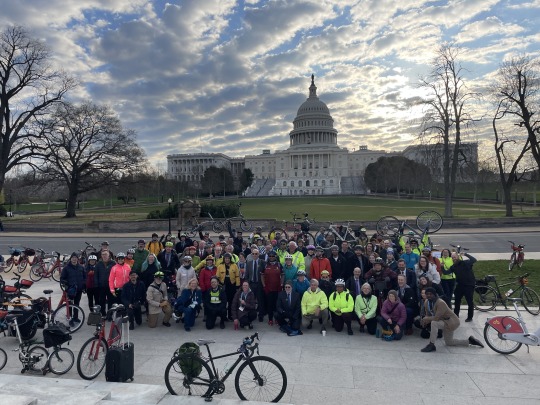
Bikeflights was represented by four Ambassadors, including Tina Beecham, Jessica Brunson and Diana Hildebrand all in person and Kecia McCullough joining virtually.
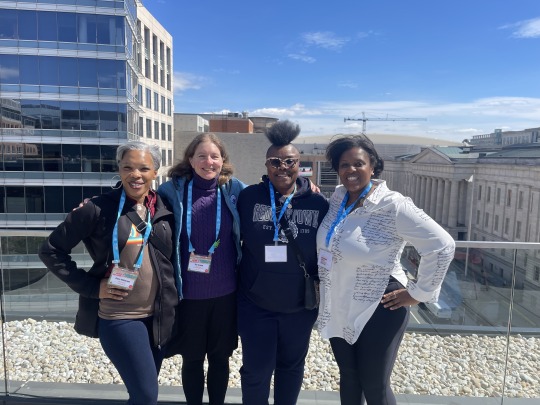
Vice President Sue George also made the trip to the nation’s capital.

Held over three days at the Martin Luther King Jr. Memorial Library and on Capitol Hill, the Summit’s energy was overwhelmingly positive. It turns out that now is a good time for bike advocacy. You can see it by simply riding around Washington, DC, where like many other parts of the country, there are increasingly more protected bike lanes, dedicated trails and paths and many other infrastructure improvements that have been proven to increase rider safety, like rumble strips and better lighting and signage.

And the momentum continues with recent infrastructure bills promising more funding to come to states and localities everywhere. Of course, there’s still plenty more work to be done. We were all reminded of a sobering statistic: there’s been a 55% increase in cycling fatalities in the US in the past 10 years.

On opening day, we especially enjoyed the presentation by Veronica O. Davis, author of “Inclusive Transportation: A Manifesto for Repairing Divided Communities.” Davis believes everyone should have access to safe, reliable and affordable transportation, and she shared some of her first-hand experiences creating more such opportunities while working for the City of Houston as the Director of Transportation & Drainage Operations. Davis painted a candid picture of what it’s really like to be on the administrative side of bike advocacy, something useful for bike advocates to better understand as they work with other administrators in similar situations.
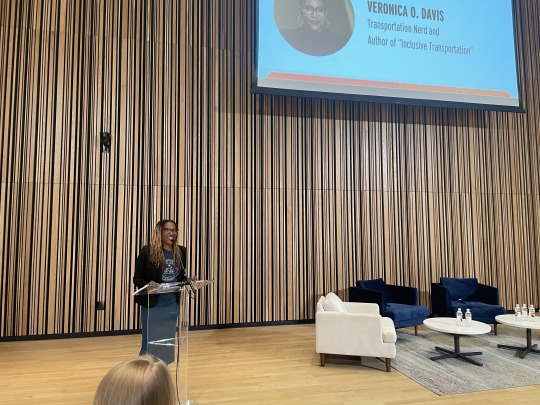
Perhaps the most entertaining speaker was Shailen Bhatt, Administrator of the Federal Highway Administration (FHWA). With his witty sense of humor, Bhatt made us laugh, even while sharing info about The Active Transportation Infrastructure & Investment Program (ATIIP) and how the FHWA encourages the implementation of projects and programs to improve safety, equity and accessibility for all road users, especially through Complete Streets Planning.

Another big highlight was getting to see our very own Bikeflights Ambassador Diane Hildebrand receive an award upon being named “Educator of the Year” by the League of American Bicyclists. Congratulations to Diane!
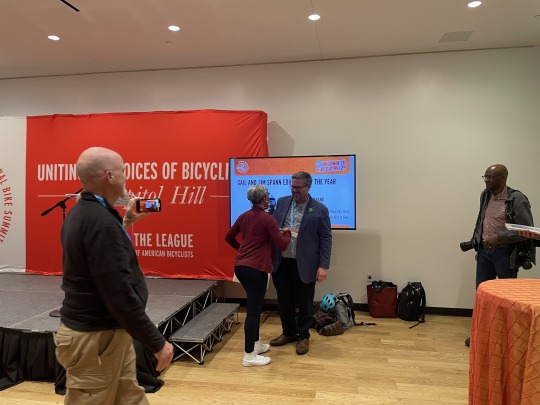
The second – or middle day – of the Summit was what is called “Lobby Day.” That’s when Summit attendees swap out their bike shoes and helmets for business attire and meet with their respective Senators and Representatives or their staff to advocate for bills and initiatives that will create a more bicycling-friendly America.
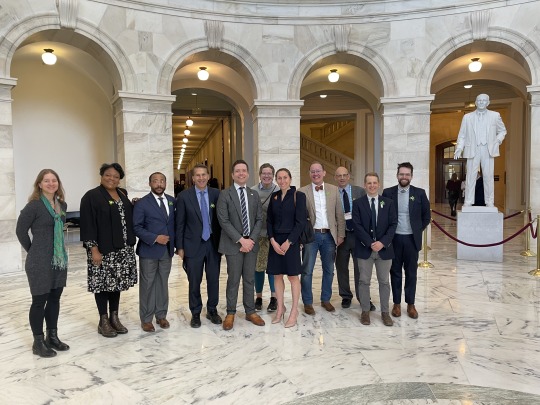
As we rode bikes and walked around Washington, we were treated to the sight of blooming cherry blossoms around the Tidal Basin and everywhere. Mother Nature may have brought peak bloom a week or two prematurely this year, but her timing worked out to be perfect for us to enjoy.

Our big takeaway from this year’s National Bike Summit is that the most important thing is to simply show up. Again and again. We were reminded by retiring Oregon Senator Earl Blumenauer and Washington Area Bicyclist Association Advocacy Director Jeremiah Lowery that nothing ever happens to make cycling better and safer if no one shows up.
So while not everyone can take the time or afford the expense of traveling to Washington to lobby their members of Congress for bills that fund cycling infrastructure improvements, there’s a lot we can all do locally… such as filling out surveys to give rider input about proposed local transportation projects, attending your city or county meetings and getting involved in your local advocacy group.

Bikeflights is proud to be a long-time sponsor of the League of American Bicyclists National Bike Summit.
3 notes
·
View notes
Text
More than 16 members of the House of Representatives introduced legislation today that would prohibit organizing, sponsoring, conducting or participating in wildlife killing contests on more than 500 million acres of U.S. public lands.
Wildlife killing contests are organized events during which participants compete for cash or prizes by killing the most, the largest or the smallest animals over a certain period of time. Each year thousands of native carnivores and other wildlife — including coyotes, foxes, bobcats, raccoons, rabbits, prairie dogs, mountain lions and wolves — are killed during these cruel, senseless competitions.
The Prohibit Wildlife Killing Contests Act of 2024, introduced by Rep. Steve Cohen (D-Tenn.) and other congressional leaders, would require the Bureau of Land Management, Bureau of Reclamation, National Park Service, U.S. Fish and Wildlife Service and U.S. Forest Service to enact regulations banning wildlife killing contests within one year of enactment of the law.
“It’s shocking that these cruel and reckless contests are still allowed on our public lands,” said Stephanie Kurose, deputy director of government affairs at the Center for Biological Diversity. “America’s wild carnivores are so important to maintaining healthy ecosystems. They deserve better than to be targeted in these thrill-kill slaughter fests.”
Ten states — Arizona, California, Colorado, Maryland, Massachusetts, New Mexico, New York, Oregon, Vermont and Washington — have already outlawed wildlife killing contests within their borders. The Humane Society of the United States conducted undercover investigations into these competitions in more than a dozen states, spurring significant public outrage against the events.
“Wildlife killing contests are cruel events that have no place in modern civil society,” said Johanna Hamburger, director and senior attorney for the Animal Welfare Institute’s Terrestrial Wildlife Program. “Participants frequently violate the fundamental hunting principle of fair chase by using bait and electronic calling devices to maximize the likelihood of winning, and animal carcasses are usually dumped once the contest is over.”
“Most people are shocked to learn that wildlife killing contests are even legal on our public lands,” said Camilla Fox, founder and executive director of Project Coyote. “Killing animals for prizes and entertainment is ethically indefensible, ecologically reckless, and anathema to sound wildlife conservation and management.”
“In addition to being unethical and unsportsmanlike, wildlife killing contests run counter to science-based wildlife management policy,” said Jennifer Eskra, director of legislative affairs of the Humane Society Legislative Fund. “This bill would end this execrable practice and protect wildlife at a national level, something that 10 states have already done.”
“Wildlife killing contests have absolutely no place in our country, including on our public lands,” said Katie Stennes, senior program manager for wildlife protection at the Humane Society of the United States. “These ‘cash for wildlife’ competitions, where native species are targeted, killed and then piled up for photos and bragging rights, is unacceptable. These animals should be respected for their intrinsic value and their key role in healthy ecosystems. We urge Congress to end senseless, wasteful wildlife killing competitions once and for all.”
Additional cosponsors of today’s legislation are Reps. Earl Blumenauer (OR-03), Cori Bush (MO-01), Gerald Connolly (VA-11), Diana DeGette (CO-01), Lloyd Dogget (TX-35), Adriano Espaillat (NY-06), Raul Grijalva (AZ-07), Jared Huffman (CA-02), Ted Lieu (CA-36), Betty McCollum (MN-04), Grace Meng (NY-06), Jerrold Nadler (NY-12), Katie Porter (CA-45), Melanie Stansbury (NM-01), Rashida Tlaib (MI-13) and Dina Titus (NV-01).
#ecology#enviromentalism#public lands#wildlife#wildlife conservation#coyote#foxes#bobcat#raccoon#rabbit#mountain lion#wolves#let wolves live#bureau of land management#national park service#us forest service#us fish and wildlife service#wildlife services
3 notes
·
View notes
Text
Historic Erv Lind Field Ceremony
On September 6th, Government officials and honored community members gathered in front of Erv Lind Field (Normandale Field) to celebrate its listing on the National Register of Historic Places. This community stadium at NE 57th Ave and Hassalo Street is the only sports facility in Oregon constructed primarily for a women’s sports league team. It served for decades as a gathering space for LGBTQ+…
#Adena Long#Brett Horner#Carmen Rubio#Cayla McGrail#Dan Ryan#Earl Blumenauer#Erv Lind Field#Fern Wilgus#Kristen Minor#Marty Stockton
0 notes
Text
Federal regulators are being pushed to investigate whether Elon Musk deceived investors in his brain-chip startup Neuralink by omitting details about the gruesome deaths of at least a dozen animals who were surgically fitted with its implants.
Four members of the US House of Representatives today alleged that Musk issued false statements in September regarding the deaths of 12 macaque monkeys, the subjects of experiments at a primate center in California between 2018 and 2020, according to a letter obtained by WIRED.
The lawmakers have urged Gary Gensler, head of the Securities and Exchange Commission (SEC), to initiate a probe into whether Musk committed securities fraud by glossing over the lethal aspects of Neuralink’s tests—a potential violation, they claim, of an SEC rule designed to shield investors from material omissions and misstatements linked with the purchase or sale of a security.
Musk, in September, claimed in a post on X (formerly Twitter) that no animal test subjects died as "a result of a Neuralink implant,” adding that the company strove early on to “minimize risk to healthy monkeys,” choosing only those who were “close to death already.”
“Mr. Musk knows this statement is false,” the lawmakers told Gensler, a former Goldman Sachs investment banker turned Wall Street sheriff.
The lawmakers’ push to see Musk investigated is spearheaded by US representative Earl Blumenauer from Oregon. As of Wednesday, three additional Democrats had joined the effort, including Barbara Lee, James McGovern, and Tony Cárdenas.
A WIRED investigation this year shed serious doubt on Musk’s animal welfare claims, finding that several macaque monkeys who’d been experimented on suffered greatly before their deaths, anguish that was prolonged in some cases to help Neuralink gather data following its surgeries. Veterinary records obtained by WIRED show many of the fatalities resulted directly from surgical complications linked by employees of the California National Primate Research Center to the implant procedure.
A former employee told WIRED this year that Neuralink's animal test subjects could not have been "close to death,” as Musk had claimed. The animals routinely underwent years of training in advance of the procedure, they said. In one experiment, a piece of a Neuralink device “broke off” during implantation, an autopsy report says, causing a fungal infection. In another, a Neuralink implant left a portion of a monkey’s cerebral cortex “focally tattered.”
“The idea that these were terminal monkeys is ridiculous,” a former Neuralink employee told WIRED. “We had these monkeys for a year or so before any surgery was performed.” (Neuralink did not respond to WIRED's request for comment at the time.)
The lawmakers’ letter to the SEC claims the animals’ deaths are directly related to the safety and marketability of Neuralink’s brain-computer interface. It is critical, they say, that investors in the company be provided with accurate information. The minimum investment accepted by outside parties is $14,995, SEC filings show.
Neither Musk nor Neuralink responded this week to inquiries concerning Musk's claims. A spokesperson for the University of California, Davis, overseer of the primate center where Neuralink’s experiments were conducted, declined to comment.
Reportedly valued at around $5 billion, Neuralink raised more than $280 million, according to filings, during a recent funding round this year. “Given the scale of these investments and Mr. Musk’s history of misleading investors,” the lawmakers write, “it is crucial that the SEC investigate whether Mr. Musk’s September 10, 2023 post violated [Rule 10b-5].”
The rule, which authorizes the SEC to regulate securities fraud, was affirmed by the Supreme Court as recently as 2014 in a case against Halliburton, one of the nation's largest oil service companies. It relies on a theory known as "fraud on the market," stipulating a causal link between a company’s value and the integrity of public information regarding its activities.
Blumenauer, who cochairs the Congressional Animal Protection Caucus, characterized the brain-computer startup as having a “distressing history of alleged animal welfare abuses,” saying the SEC investigation should determine whether Musk intentionally misled the public by “misrepresenting the harm caused by botched animal trials.”
“When dealing with alleged animal welfare violations as egregious as those leveled against Musk, there needs to be greater urgency to hold him accountable,” he told WIRED in a statement.
Musk has previously faced investigations for allegedly misleading investors. In 2018, the SEC charged him with securities fraud over a series of false tweets regarding a potential push to take Tesla private. In a settlement, Musk was forced to step aside as chairman for three years and personally pay a $20 million fine, with Tesla fined an additional $20 million. As a condition of the settlement, Musk neither admitted nor denied the allegations.
In an unrelated case, the SEC urged a federal judge last week to compel Musk to testify as part of a probe into his $44 billion takeover of Twitter.
In May, the US Food and Drug Administration issued approval for Neuralink to begin human trials, having previously rejected the company’s application over safety concerns. Reuters reported that those concerns centered largely around whether the electrodes connected to the Neuralink device were prone to detaching and moving freely around after being connected to a subject’s brain.
In a report this month, Bloomberg News claimed that thousands of people have expressed interest in obtaining an implant from Neuralink, a device that Musk once famously described as a “Fitbit in your skull.” The procedure will involve removing a coin-sized piece of the subject’s cranium and allowing a proprietary robot to weave superthin wires into their brain.
Read the full letter below:
The Honorable Gary Gensler Chair U.S. Securities and Exchange Commission 100 F St. NE Washington, DC 20549 Dear Chair Gensler: Thank you for your ongoing work to protect investors and safeguard the integrity of our financial system. We write to request that the Securities and Exchange Commission (SEC) investigate whether Elon Musk, Chief Executive Officer of the medical device company Neuralink (Central Index Key # 0001708503), committed securities fraud by making intentionally misleading statements to investors. Since 2016, Neuralink has conducted experiments on animals with the intention of developing an implantable brain-computer interface. Between May 2017 and December 2020, employees performed invasive, exploratory brain studies on rhesus macaques at the University of California, Davis (UC Davis). During most of the experiments, Neuralink employees drilled two dime-sized holes in the animals’ heads, implanted electrodes in their brains, and attached titanium plates to their skulls using bone screws. In 2021, as a result of a California Public Records Act lawsuit against UC Davis, the Physicians Committee for Responsible Medicine obtained veterinary records from Neuralink’s experiments that show that the implantation of the Neuralink device caused debilitating health effects in the monkeys. Test monkeys suffered from chronic infections, swelling in the brain, “remnant electrode threads” from the device, a “tattered” cerebral cortex, paralysis, seizures, loss of coordination and balance, and depression. Public records reveal that at least 12 young, previously healthy monkeys were euthanized by Neuralink as a direct result of problems with the company’s implant.
On September 10, 2023, Mr. Musk responded to animal welfare concerns at Neuralink via a post on the social media platform X, which he also owns. He wrote:
“No monkey has died as a result of a Neuralink implant. First our early implants, to minimize risk to healthy monkeys, we chose terminal mon[k]eys (close to death already)[.]”
Yet Mr. Musk knows this statement is false. Monkey health records show that, while several animals had suffered physical trauma and been used previously in experiments at UC Davis, there is no evidence that they were “close to death,” as Mr. Musk stated. Rhesus macaques often live to about 25 years in captivity, with some living to 40. But the average age of the 12 monkeys euthanized by Neuralink was 7.25 years when they were moved to the company’s experimental protocol.
The animals’ deaths and the reasons for their deaths relate directly to the safety and marketability of Neuralink’s brain-computer interface. It is critical that the company provide investors with factually accurate information, and thus we are concerned that Mr. Musk may have violated SEC Rule § 240.10b-5:
It shall be unlawful for any person, directly or indirectly, by the use of any means or instrumentality of interstate commerce, or of the mails or of any facility of any national securities exchange...[t]o make any untrue statement of a material fact or to omit to state a material fact necessary in order to make the statements made, in the light of the circumstances under which they were made, not misleading...in connection with the purchase or sale of any security.
In its 2018 complaint against Mr. Musk for posting misleading messages on the platform then known as Twitter, the SEC referenced his 22 million followers, emphasizing the reach of his social media account: “His tweets were published instantaneously to those people and were also publicly available to anyone with Internet access.”
Mr. Musk’s online reach has grown significantly since 2018. Today, he has 162.9 million followers on X, the most of any account on the platform, and his September 10 post has already received more than 788,000 views.
The company claims to have raised $280,274,981 in investments, with a minimum investment accepted from any outside investor of $14,995, according to its August 2023 Form D notice. Given the scale of these investments and Mr. Musk’s history of misleading investors, it is crucial that the SEC investigate whether Mr. Musk’s September 10, 2023 post violated SEC Rule § 240.10b-5.
Thank you for considering this request.
3 notes
·
View notes
Text
WASHINGTON (AP) — The House voted Friday to reinstate tariffs on solar panel imports from several Southeast Asian countries after President Joe Biden paused them in a bid to boost solar panel installations in the U.S., a key part of his climate agenda.
The 221-202 vote sends the measure to the Senate, where lawmakers from both parties have expressed similar concerns about what many call unfair competition from China. Biden has vowed to veto the measure if it reaches his desk.
The House vote would overturn Biden's action last year pausing threatened tariffs that had led to delays or cancellations of hundreds of solar projects across the United States.
Some U.S. manufacturers contend that China has essentially moved operations to four Southeast Asian countries — Thailand, Vietnam, Malaysia and Cambodia — to skirt strict anti-dumping rules that limit imports from China.
A Commerce Department inquiry last year found likely trade violations involving Chinese products. Biden halted the tariffs for two years before the Commerce investigation was completed, saying he was responding to an emergency that threatened the availability of electric power to meet demands from U.S. homes and businesses.
Before Biden acted, the threat of tariffs from the Commerce Department inquiry had led to delays or cancellations of hundreds of solar projects in the U.S. as investors moved to protect themselves against potential penalties as high as $1 billion that could be imposed retroactively.
The U.S. industry argues that imports of solar panels are needed as solar installations ramp up to meet increased demand for renewable energy. Solar power is a key part of Biden’s goal to achieve 100% clean electricity by 2035.
Rep. Jason Smith, R-Missouri, said Friday that restoring the tariffs would hold China accountable while protecting U.S. jobs and workers. Tariffs would protect American manufacturers who are facing unfair competition from China, which is subsidizing its products and selling them at low prices, Smith said.
"These trade abuses are well-known to all of us in this chamber,'' said Smith, chairman of the tax-writing House Ways and Means Committee.
“By shipping its products through Cambodia, Malaysia, Taiwan and Vietnam, (Chinese officials) have set up a scheme that cheats American workers and consumers,'' Smith said. “We know there's wrongdoing going on. We know China is cheating, and that's precisely why members of both parties were stunned and disappointed when the White House made the misguided decision'' to halt the tariffs for two years.
Rep. Earl Blumenauer, D-Ore., said the House action would “punish U.S. workers” and the solar industry "and set us back on our climate goals.''
Rep. Judy Chu, D-Calif., said the two-year pause was “not a perfect solution,'' but offered “a short-term bridge" as the U.S. solar industry moves to produce more solar panels at home.
The White House said Biden’s action boosted an industry crucial to his climate change-fighting goals while not interfering with or shutting down the Commerce investigation.
#nunyas news#better headline#house gop moves to increase#US manufacturing and reduce carbon polloution#by making purchasing locally produced goods#more attractive
6 notes
·
View notes
Text
This is current as of 11/28/23. The bill was introduced on 09/12/23. It is still in committee and has not been voted on yet.
Just repeating from above: go to the bill's page on GovTrack.us to find out what the current status of the bill is, if you are seeing a reblog of this later. Scroll down, and you will see a timeline that will show you what stage the bill is in. The bill is currently in the Finance committee.

[above: a screenshot from the GovTrack.us website of this bill's timeline. It shows that an earlier version of the bill was introduced on 4/28/22, and that this version of the bill, which is active, was introduced on 9/12/23. There are further markers on the timeline that are not active at the moment, but would show as the bill advances.]
Also as a note: this version of the bill has 7 sponsors. 4 are Republicans, and 3 are Democrats.
D Brown, Sherrod [D-OH] Primary Sponsor (on Finance committee) D Wyden, Ron [D-OR] Original Cosponsor (Finance committee chair) D Casey, Robert “Bob” [D-PA] Original Cosponsor (on Finance committee) R Cassidy, Bill [R-LA] Original Cosponsor (on Finance committee) R Lankford, James [R-OK] Original Cosponsor (on Finance committee) D Hassan, Margaret “Maggie” [D-NH] Oct 3, 2023 (on Finance committee) R Collins, Susan [R-ME] Original Cosponsor R Rounds, Mike [R-SD] Oct 3, 2023
So, even if your senators are Republicans, if they are any of the people on this list, it's not a bad idea to contact them to show your support for a bill they are co-sponsoring.
Here is the full list of the Senate Finance committee. If any of your senators are on this list, it's a good idea to contact them to show your support.
PLEASE NOTE: bill "S. 2767: SSI Savings Penalty Elimination Act" is a bill in the SENATE, and currently is in the Senate Finance committe.
But, Democrat Brian Higgins (NY 26th district) introduced an identical bill in the House on the same day (9/12/23), "H.R. 5408: SSI Savings Penalty Elimination Act". It is currently in the House Ways and Means committee. Here is its page at GovTrack.us.
The following are the sponsors of the bill in the House:
D Higgins, Brian [D-NY26] Primary Sponsor (Ways and Means) R Fitzpatrick, Brian [R-PA1] Original Cosponsor (Ways and Means) D Blumenauer, Earl [D-OR3] Oct 26, 2023 (Ways and Means) D Kildee, Daniel [D-MI8] Oct 26, 2023 (Ways and Means) R Lawler, Michael [R-NY17] Oct 26, 2023 R Molinaro, Marcus [R-NY19] Oct 26, 2023
(Dates beside the names above indicate that they were not original cosponsors, but that they signed on as sponsors on that date.)
Here is a link to the full list of the House Ways and Means committee. Again, if you see your rep in the list above, or on the list at that link, it may be especially useful for you to contact their office to show support.
US people with disabilities in the supplemental security income (SSI) program can't have a penny over $2K in their bank account at any time in order to keep their benefits.
You know this economy. That amount is completely unlivable & makes it hard for people with disability to save for the future or have a safety net for emergencies.
A new bill would raise the max to $10K (or $20K for married couples). It would make a world of difference.
Show support, sign this petition.
37K notes
·
View notes
